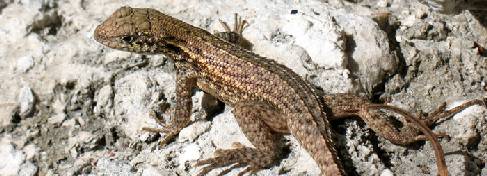The Green River Formation, a sedimentary feature of Wyoming and northern Colorado, is widely recognized for its high quality fossils of fish and other creatures. It has been dated at 40 million years and older. What are the odds, then, of original soft tissue fossils being found encased in its rock?
A new study showed that a "fossilized" lizard leg found in the formation is not made up of minerals, but instead still has the original skin and connective tissue. In a study published in the British scientific journal Proceedings of the Royal Society B, paleontologists applied a new technique that was able to detect the presence of original biomolecules such as amino acids, yet without damaging the sample.1 Prior studies relied on sample-destroying techniques, as in the case of one that sequenced proteins from hadrosaur blood vessels.2
This new study used infrared mapping, which detected light that reflected tell-tale patterns caused by organic molecules. The researchers then employed other techniques to cross-check whether or not the infrared mapping results were accurately detecting soft tissue that had not been replaced by minerals. Synchrotron rapid-scanning X-ray fluorescence detected original protein, and the results of X-ray diffraction and mass spectrometry were also consistent with this conclusion. In the end, the claim that the lizard tissue had not mineralized was thoroughly defensible.
The authors wrote:
Taken together, all the analyses performed in this study strongly suggest that the fossilized reptile skin in BHI-102B is not a simple impression, mineralized replacement or an amorphous organic carbon film, but contains a partial remnant of the living organism's original chemistry, in this case derived from proteinaceous skin.1
Of course, this result forces a re-evaluation of the fossil's evolutionary age assignment. Even when kept dry and sterile, skin cells turn to dust as their proteins spontaneously deteriorate. But this fossil lizard skin from the Green River Formation shows at most thousands, not millions, of years' worth of decay.
This particular rock formation has features that indicate it was formed when a giant inland lake catastrophically drained into the Pacific Ocean. Rapid, wholesale burial of so many fish and other creatures was necessary for their remains to have been protected from scavengers and preserved as fossils. And recent burial in water-carried sediments would have been necessary to explain the persistence of these original tissues.
This catastrophic drainage and burial surely occurred just thousands of years ago—as the original tissue in this lizard leg attests. And this would be consistent with the biblical history of a young earth.
References
- Edwards, N. P. et al. Infrared mapping resolves soft tissue preservation in 50 million year-old reptile skin. Proceedings of the Royal Society B. Published online before print March 23, 2011.
- Schweitzer, M. H. et al. 2009. Biomolecular Characterization and Protein Sequences of the Campanian Hadrosaur B. canadensis. Science. 324 (5927): 626-631.
* Mr. Thomas is Science Writer at the Institute for Creation Research.
